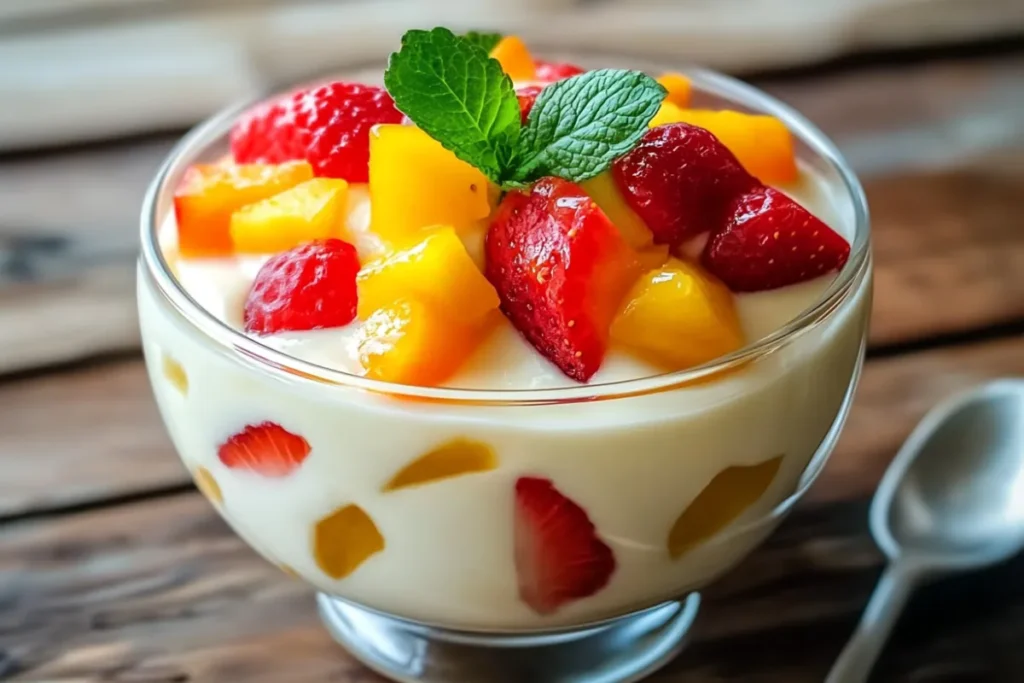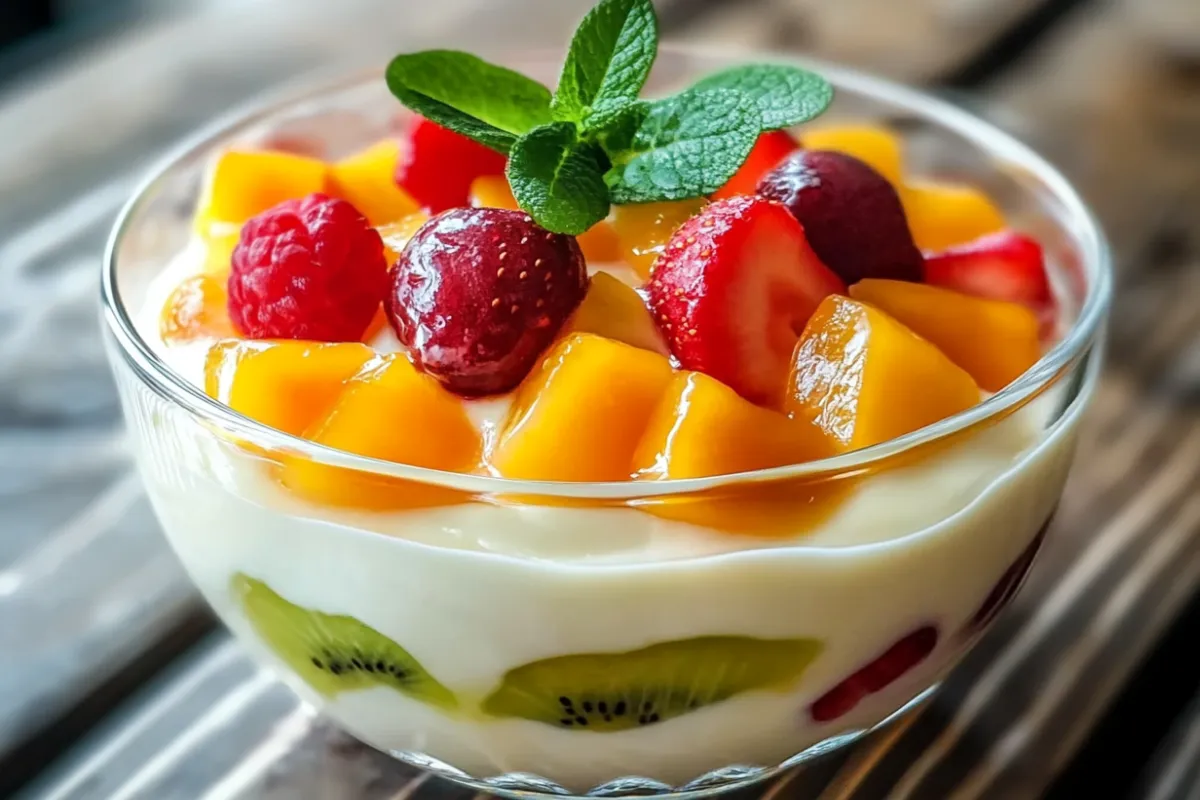Last Updated on February 15, 2025 by Simon
Nata fruit pudding recipe is a delightful, refreshing dessert that brings together the tropical flavors of nata de coco and fresh fruits in a smooth, creamy pudding base. This recipe is perfect for a warm day, offering a light yet satisfying treat that can easily become a crowd favorite. Whether you’re hosting a gathering, preparing a meal for your family, or simply treating yourself, this easy-to-make dessert will bring joy to your taste buds.
If you’ve ever had nata de coco, you know it’s a gelatinous, chewy substance made from fermented coconut water. It has a mildly sweet flavor and a unique texture that pairs beautifully with various fruits. In this pudding, nata de coco is combined with the natural sweetness of fruits like mango, papaya, and pineapple, making it a delicious dessert that’s both creamy and refreshing.
Whether you are preparing for a celebration or just want a sweet treat to enjoy, this pudding is a great option. The creamy, smooth base of the pudding balances the chewy texture of the nata and the juicy fruits, making each spoonful a burst of tropical goodness.
Table of contents
Why The Nata Fruit Pudding Recipe Works
This nata fruit pudding recipe works so well because it combines a variety of textures and flavors that complement each other perfectly. The creaminess of the pudding contrasts with the chewy nata de coco, while the sweetness of the fruits brings a refreshing balance to the dessert. Here’s why this recipe is a crowd-pleaser:
- Nata de Coco: This ingredient is a star in this recipe. Its unique texture adds an interesting element to the pudding. It’s chewy and slightly crunchy, providing a satisfying contrast to the smoothness of the pudding base. Plus, it’s incredibly versatile and pairs well with other tropical fruits.
- Fresh Fruit: The use of fresh tropical fruits in this pudding brings a burst of natural sweetness and color, making the dessert look as good as it tastes. Fruits like mango, pineapple, and papaya are not only flavorful but also high in vitamins and antioxidants.
- Simple to Prepare: Despite being a multi-layered dessert, this pudding is easy to make. The pudding base only requires a few ingredients, and assembling the dessert is a breeze. You can also customize it based on the fruits you have on hand, making it adaptable to different seasons.
- Customizable: This pudding is versatile in terms of flavors. You can use whatever fruits are in season or what you enjoy the most. Additionally, you can adjust the sweetness to suit your taste by adding more or less sugar or sweetener to the pudding base.
This dessert is not only delicious, but it’s also light enough to serve after a big meal without being overly heavy. Plus, it can be made ahead of time, allowing the flavors to meld together and giving you a stress-free dessert option for parties and gatherings.
Ingredients Breakdown
- 2 cups of full-fat coconut milk (or regular milk for a non-dairy option)
- 1/2 cup of sugar (or honey, maple syrup, or any sweetener of choice)
- 1/4 cup of cornstarch
- 1/2 teaspoon of vanilla extract
- Pinch of salt
Fruit Layer:
The Pudding:
- 1 cup of diced mango (fresh or frozen)
- 1/2 cup of diced pineapple
- 1/2 cup of diced papaya
- 1/2 cup of nata de coco (you can find this in most Asian supermarkets or online)
For Garnish:
- Fresh mint leaves (optional)
- Extra fruit for decoration (optional)
The main ingredient that makes this pudding stand out is nata de coco, a chewy, coconut-based gelatin that adds both texture and a subtle coconut flavor. This unique ingredient is high in fiber and low in calories, making it a guilt-free addition to the pudding.
Step by Step Instructions
- Prepare the Pudding Mixture: In a medium saucepan, whisk together coconut milk, sugar, cornstarch, vanilla extract, and a pinch of salt until smooth and well combined. Make sure there are no lumps in the mixture before placing it on the heat.
- Cook Until Thickened: Set the saucepan over medium heat, stirring constantly with a whisk or silicone spatula to prevent clumping or burning. Cook for 5-7 minutes until the mixture begins to thicken and reaches a smooth, pudding-like consistency. Once it coats the back of a spoon, remove it from the heat.
- Chill the Pudding: Transfer the pudding to a heatproof bowl and let it cool slightly. Cover the surface with plastic wrap, pressing it directly onto the pudding to prevent a skin from forming. Refrigerate for at least 2 hours, or until fully chilled and set.
- Assemble the Dessert: Once the pudding has chilled, take serving cups or dessert glasses and start layering. Begin with a spoonful of coconut pudding, followed by a layer of fresh fruit (such as mango, strawberries, or lychee), and nata de coco. Repeat the layers as desired.
- Garnish and Serve: Top the dessert with mint leaves for a fresh touch. Serve chilled and enjoy this creamy, tropical treat!
Pro Tips for Success

- Use Full-Fat Coconut Milk for Creaminess
For the creamiest texture, always opt for full-fat coconut milk, which will create a rich, velvety pudding. If you prefer a lighter version, you can use low-fat coconut milk or regular milk, but the pudding may be less creamy. - Adjust Sweetness to Taste
The amount of sugar you use can be adjusted to suit your preference. If you are using very sweet fruit, you can reduce the sugar in the pudding base. Taste the mixture before cooking to make sure it’s sweet enough for your liking. - Layering for Texture
When assembling the pudding, alternate between layers of pudding, fruit, and nata de coco. This layering technique ensures each bite is packed with flavor and different textures, making every spoonful delightful. - Use Fresh or Frozen Fruit
While fresh fruit provides the best flavor and texture, frozen fruit can also be used. Just make sure to thaw it and drain any excess liquid to avoid watering down the pudding. - Chill for the Best Results
After assembling, let the pudding chill in the fridge for at least two hours to allow the flavors to meld and the pudding to set properly. You can even make this dessert the day before and store it in the fridge overnight.
Variants of the Nata Fruit Pudding Recipe
- Tropical Fruit Twist
Experiment with different tropical fruits like kiwi, dragon fruit, or passion fruit. These fruits will not only add variety to the flavor but also bring vibrant colors to your pudding, making it even more visually appealing. - Vegan Version
For a fully vegan version, substitute the regular milk with a plant-based milk like almond, oat, or soy milk. You can also replace the sugar with a natural sweetener like agave nectar or stevia for a more health-conscious option. - Layered Nata Coconut Pudding
For an even more indulgent version, add a layer of coconut cream to the pudding, giving it a richer flavor and a thicker texture. You can also add toasted coconut flakes on top for a crunchy texture.
Serving Suggestions
Nata fruit pudding is best served chilled, making it an ideal dessert for hot summer days. It can be served in small individual cups, parfait glasses, or as one large dessert, depending on your preference.
For an extra touch of luxury, serve the pudding with a drizzle of coconut cream or a sprinkling of toasted coconut flakes on top. It pairs well with tropical cocktails or a light iced tea, providing a refreshing end to any meal.
Recipe Card
FAQs for Nata Fruit Pudding Recipe
Yes, absolutely! While mango, papaya, and pineapple are popular choices, feel free to get creative. You can substitute or mix other tropical fruits like lychee, dragon fruit, or guava. Just make sure the fruits are ripe and juicy to enhance the flavor of the pudding.
If you’re looking to make this recipe dairy-free, coconut milk is already a great option. However, you can also use almond milk or soy milk as alternatives.
Yes! The recipe calls for sugar, but you can adjust the amount to your taste or use a sugar substitute like Stevia or monk fruit. If you’re trying to reduce sugar for health reasons, opt for unsweetened coconut milk and decrease the sugar by half.
To store leftovers, place the pudding in an airtight container and refrigerate it for up to 3 days. The pudding will thicken as it cools, so if you find it too firm when reheating, simply add a splash of milk or coconut milk and stir until smooth.
Yes, this pudding is a great make-ahead dessert. You can prepare it up to 2 days in advance and store it in the fridge. When serving, you can add fresh fruits or even a drizzle of honey on top for an extra touch.
If your pudding is too runny, it’s likely that the cornstarch wasn’t mixed thoroughly with the coconut milk or it wasn’t cooked long enough to fully thicken.
Health Benefits of Nata Fruit Pudding Recipe
Nata Fruit Pudding offers several health benefits thanks to its wholesome ingredients:
- Coconut Milk: Rich in medium-chain triglycerides (MCTs), coconut milk is known for its anti-inflammatory properties and ability to support heart health. It’s also a good source of vitamins C, E, and B-complex.
- Fruits: Mango, papaya, and pineapple are packed with vitamins, antioxidants, and fiber. Mangoes are rich in vitamin A and C, promoting healthy skin and immunity. Papayas contain papain, an enzyme that aids digestion, while pineapples have bromelain, which may help reduce inflammation.
- Nata de Coco: This coconut gel is a great source of fiber, which promotes digestive health and supports a healthy gut. It’s also low in calories, making it a light addition to the pudding.
Final Thoughts
This Nata Fruit Pudding is a perfect way to bring the refreshing flavors of the tropics into your home. Whether you’re hosting a gathering, preparing a special treat for yourself, or looking for a dessert that everyone will love, this easy-to-make pudding is sure to please. With its creamy coconut base, chewy nata de coco, and fresh fruits, it’s a delightful balance of flavors and textures that will transport you straight to a sunny beach.
If you enjoyed this recipe, be sure to check out my other pudding dessert, the Rice Pudding Recipe. It is equally as delicious and refreshing, perfect for warm weather or whenever you need a sweet escape.
Don’t forget to share your pudding creations with me! Happy cooking, and I hope you enjoy this treat as much as I do.


